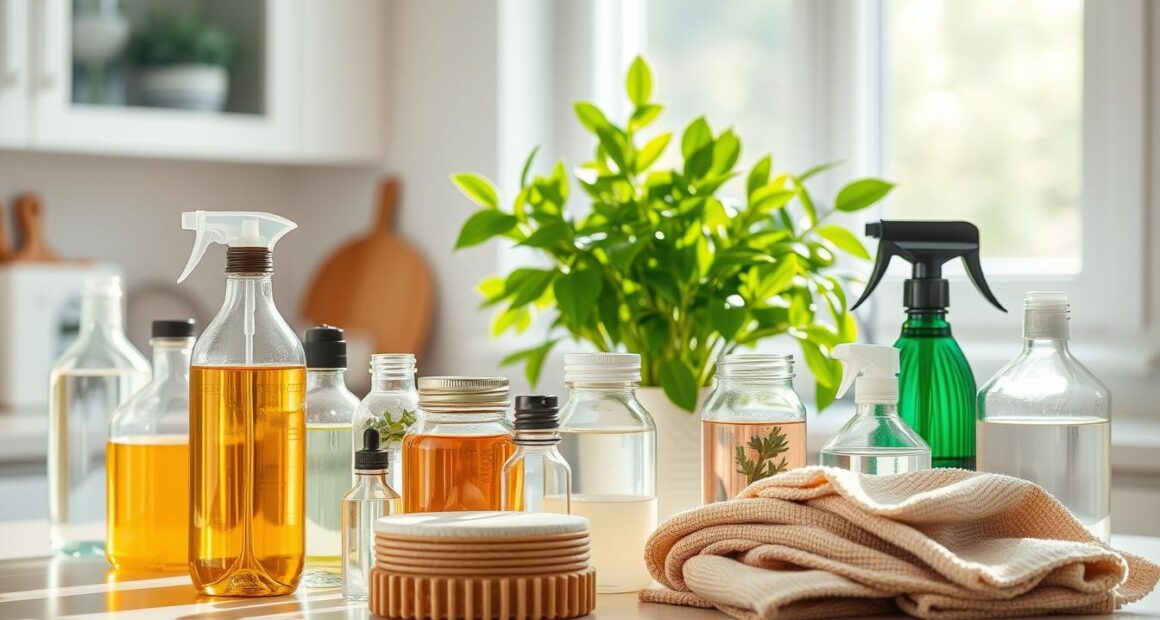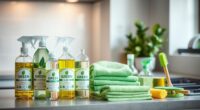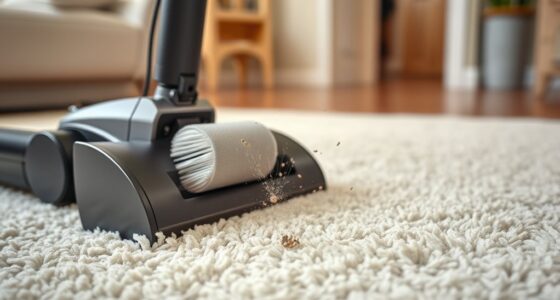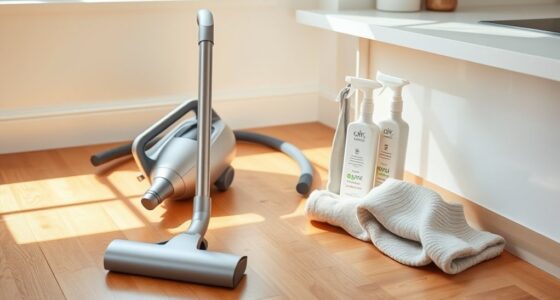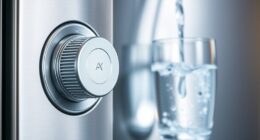The eco-friendly cleaning products market is set to grow by 11.4% yearly until 2028. This boom shows that more people are choosing sustainable options for the planet and our health. With 75% of shoppers ready to spend extra on organic items, eco-friendly cleaning is becoming essential.
Every day, the products we pick impact both us and the earth. Traditional cleaners are full of chemicals that can harm our health and hurt the planet. Yet, green cleaning products offer a safe, effective option. This guide will show you why choosing eco-friendly cleaning is vital for a healthy home.
There’s a ton of helpful info out there, from key ingredients to making your cleaners. This guide encourages you to live a greener life. It’ll change how you clean by choosing eco-safe products. These choices protect the environment and keep you feeling good.
Key Takeaways
- The eco-friendly cleaning market is expected to grow at a CAGR of 11.4%.
- Over 75% of consumers are willing to pay more for organic products.
- Eco-cleaning products avoid harmful chemicals found in conventional cleaners.
- Sustainable cleaning choices contribute to a healthier planet.
- This guide provides insights into green cleaning and DIY solutions.
Understanding the Importance of Eco-Cleaning
Eco-cleaning improves your health and helps the environment. Traditional cleaners have harmful chemicals like ammonia and chlorine. These can cause breathing problems and skin issues. Eco-friendly products use natural ingredients such as vinegar and baking soda. This reduces your contact with toxic substances.
The impact of cleaning products isn’t just personal. Traditional cleaners release VOCs, harming indoor air quality. People spend about 90% of their time inside. Inside, VOCs can be up to ten times higher than outside. This can lead to headaches and serious breathing problems.
Choosing sustainable cleaning methods helps the planet. Eco-friendly products use biodegradable agents and reusable items. This reduces waste and your carbon footprint. The eco-cleaning market is growing, making green products more affordable. They are now as effective as traditional cleaners without the health risks.
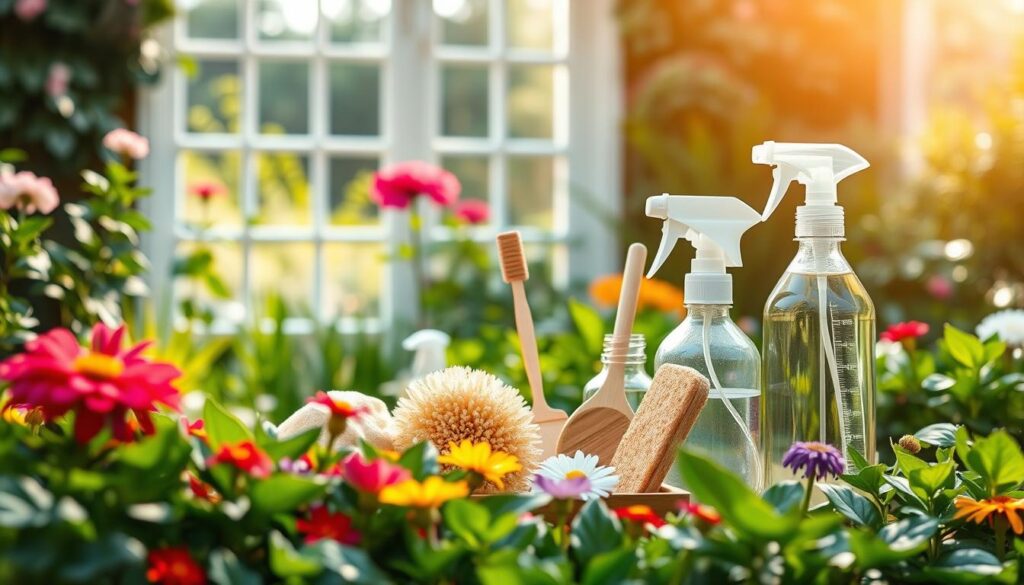
What Are Green Cleaning Products?
Green cleaning products focus on being safe for health, safety, and the planet. They skip harsh chemicals, using natural cleaning agents like plant extracts and essential oils instead. These choices make your home safer and help protect the environment.
Traditional cleaners often have bleach or ammonia, releasing harmful substances into your home. These chemicals can dirty the air inside and may trigger allergies or breathing problems. But eco-friendly cleaning solutions aim to make the air in homes healthier, offering a safer place to live.
Though some think green cleaning items cost more, they can actually save money over time. A single green cleaner can work on many surfaces, saving you from buying lots of different products. Companies such as Hyve even offer refillable products, cutting down on plastic waste.
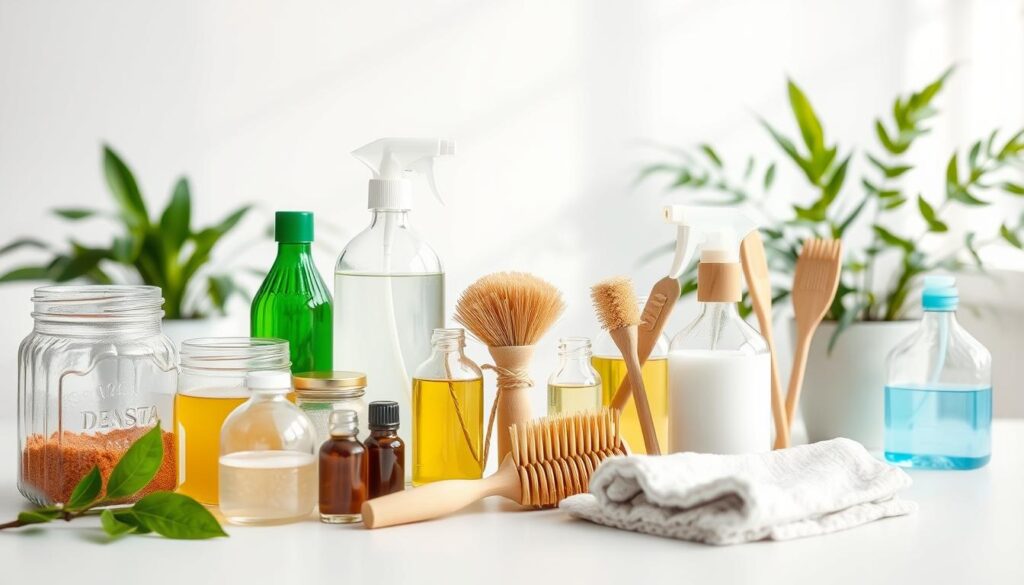
Green cleaning products often break down naturally, not hurting rivers or oceans when washed away. They support safe cleaning ways while still working well. Items like white vinegar and baking soda fight germs without bad chemicals.
To start using green products, try swapping out one regular cleaning item first. This easy step can help you begin a healthier cleaning habit.
Benefits of Using Eco-Friendly Cleaners
Switching to eco-friendly cleaning solutions has many perks for your home. They help make the air cleaner and healthier. Unlike standard cleaners, these don’t send harmful chemicals into the air. This makes your home a safer place for you and your family.
Eco-friendly cleaners also boost health by using natural, non-toxic ingredients. They cut down on skin and breathing problems. This is especially good for kids and pets. People using green cleaners often face fewer health issues from chemical exposure.
There’s more to these products than just health benefits. They’re concentrated, so a little goes a long way, saving you money and reducing waste. Plus, they often come in packaging that’s either refillable or recyclable. This helps lessen the environmental harm from plastic.

Using green cleaners like probiotic options also offers lasting cleanliness. They keep working well after you’ve applied them. Choosing these products means you’re picking a safer, more eco-friendly way to keep your house clean. This helps create a better home for everyone.
Key Ingredients to Look for in Green Products
Choosing the right cleaning items is key for your health and the planet. Look for natural ingredients in cleaning products like white vinegar, baking soda, lemon juice, and essential oils. These are effective and gentle on the environment. Try to pick products that promote eco-friendly components and avoid harsh chemicals.
It’s important to read labels to understand identifying safe cleaning products. Search for marks like Green Seal or the EPA Safer Choice label. These show the product is safe for you and the earth. Products that list all ingredients clearly are best. They help you stay away from bad chemicals that hurt your health.
Avoid harmful stuff like phthalates because they mess with hormones. Volatile organic compounds (VOCs) are bad too, as they pollute your air indoors. Choose products with ingredients that break down easily. This lessens health risks and helps those with breathing issues.
Picking items with planet-friendly packaging is also smart. Using refillable products cuts down on trash, which is good for sustainability. When you choose such products, you help both your home and the earth.
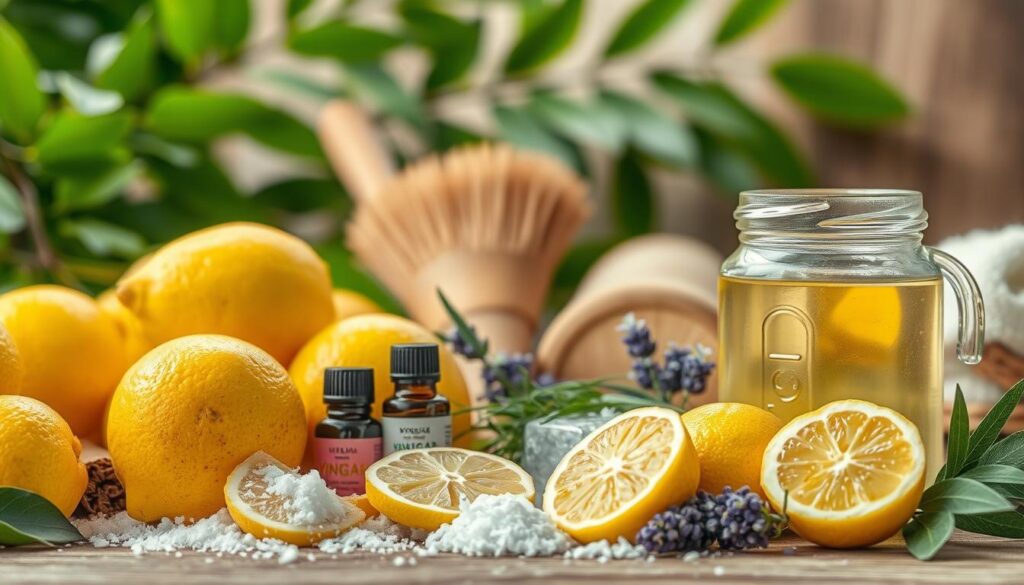
DIY Cleaning Solutions: A Beginner’s Guide
Making your own cleaning products is both rewarding and kind to the earth. You can create custom solutions that are perfect for your home and safe for the environment. With everyday items like vinegar, baking soda, and citric acid, you can make your own eco-friendly cleaners. These cleaners not only save money but also help cut down on waste from store-bought products. Here’s an easy way to start.
Using Common Ingredients for Cleaning
Vinegar is a key item for homemade cleaners. It’s great for removing mineral deposits from appliances such as dishwashers and kettles. Bicarbonate of soda, or baking soda, is also crucial. It removes odors and boosts laundry detergent’s power. Plus, it’s effective against hard stains when mixed with water to form a paste.
Citric acid is another star cleaner, even better than vinegar in some cases. It’s also more eco-friendly due to its cardboard packaging. Citric acid kills germs and freshens up surfaces wonderfully. For really tough jobs, soda crystals help unclog drains and remove limescale from appliances.
Simple Recipes for Homemade Cleaners
Here are a couple of simple recipes for natural cleaners to try:
- All-Purpose Cleaner: Mix water and white vinegar in equal parts in a spray bottle. It’s great for many surfaces.
- Baking Soda Scrub: Mix half a cup of baking soda with water to make a thick paste. This is good for cleaning sinks, stovetops, and even getting stains out of fabrics and carpets.
Using these DIY cleaning solutions helps you control your cleaning process and makes your home healthier. By choosing natural ingredients, you reduce exposure to chemicals. This makes your house safer for everyone, including kids and pets.
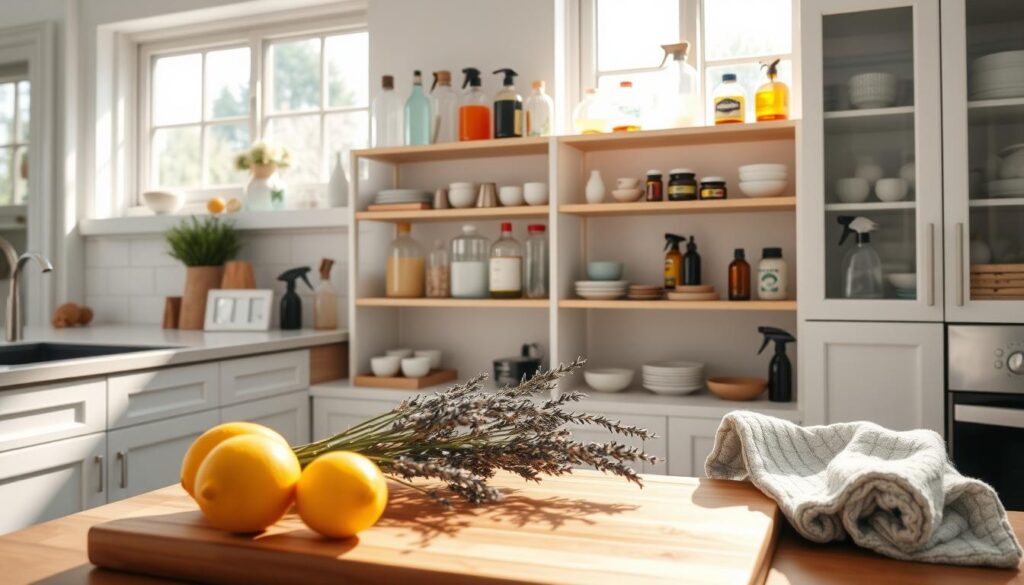
How to Choose the Right Eco-Cleaning Products
Making smart choices for your home and planet starts with knowing about eco-friendly cleaners. It’s important to learn what makes a cleaning product green. Look for safe, non-toxic ingredients and avoid harmful chemicals like synthetic fragrances and chlorine bleach.
It’s key to check out a brand’s green practices before picking their products. Brands like Good Vibes Clean use simple ingredients and eco-friendly packaging. They prefer materials that are recycled and biodegradable, lessening their impact on the earth. Look for certifications like EPA Safer Choice or Green Seal to know a product meets strict safety and quality checks.
Choosing eco-products can make your home’s air cleaner. Unlike traditional cleaners, which can release harmful compounds, green cleaners support a healthy indoor space. For example, cleaners with probiotics not only do a great job cleaning. They also protect against dirt and allergens longer.
The table below shows important aspects to consider when picking eco-cleaning products:
| Feature | Eco-Friendly Cleaners | Conventional Cleaners |
|---|---|---|
| Ingredient Transparency | Recognizable and pronounceable ingredients | Often complex, unpronounceable chemicals |
| Health Safety | Non-toxic, safe for sensitive skin | Potential irritants linked to allergies |
| Environmental Impact | Biodegradable, recyclable packaging | Disposable plastics contributing to waste |
| Certifications | EPA Safer Choice, Green Seal | Generally unregulated |
| Lasting Effects | Prolonged cleaning effects (e.g., probiotics) | Short-term effectiveness |
When you know these features, you’ll make choices that fit your health and values better. Switching to green cleaning products improves your space and helps the environment too.
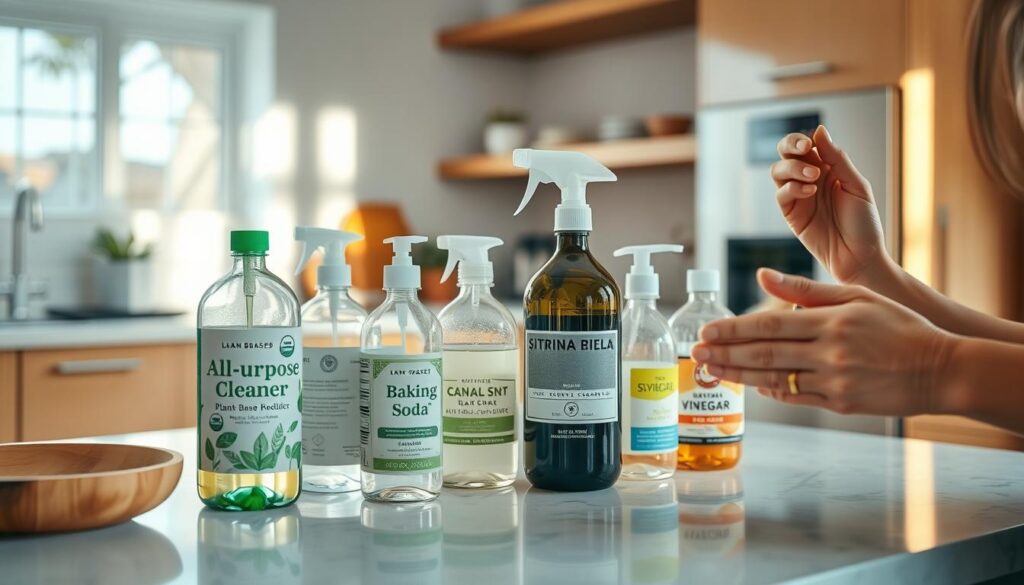
A Beginner’s Guide to Choosing Green Cleaning Products
Finding the right green cleaning products can be a challenge with so many choices. Use a green cleaning checklist to make things easier. When shopping, look at ingredients, how green the product is, and if the brand is open about their products.
Start with the ingredients. Try to pick products with ingredients you can easily say and know. Stay away from fake smells, phosphates, or bleach as they’re bad for health and rivers. Choose products that are good for the air inside by not using stuff that makes breathing hard.
Knowing how well green cleaners work is important. Don’t just stick to old cleaners. Try new ones like probiotics that keep cleaning after you’re done. Go for brands that prove their cleaners really work.
How green a cleaning product is matters a lot. Products that come in refills or use less plastic are better for the earth. The company should be honest about how they make products and support being eco-friendly.
To help you pick green cleaning products, here’s a quick list:
| Criteria | What to Look For | Avoid |
|---|---|---|
| Ingredients | Recognizable, pronounceable, and plant-based | Synthetic fragrances, phosphates, chlorine bleach |
| Effectiveness | Long-lasting cleaners (like probiotics) | Traditional, harsh chemicals |
| Environmental Impact | Eco-friendly packaging and sustainable sourcing | Single-use plastics, harmful production processes |
| Brand Transparency | Clear labels, certifications, and ingredient sourcing | Vague labeling and unverified claims |
With this checklist, you can easily find the best green cleaners. Choosing right helps your home and the planet too.
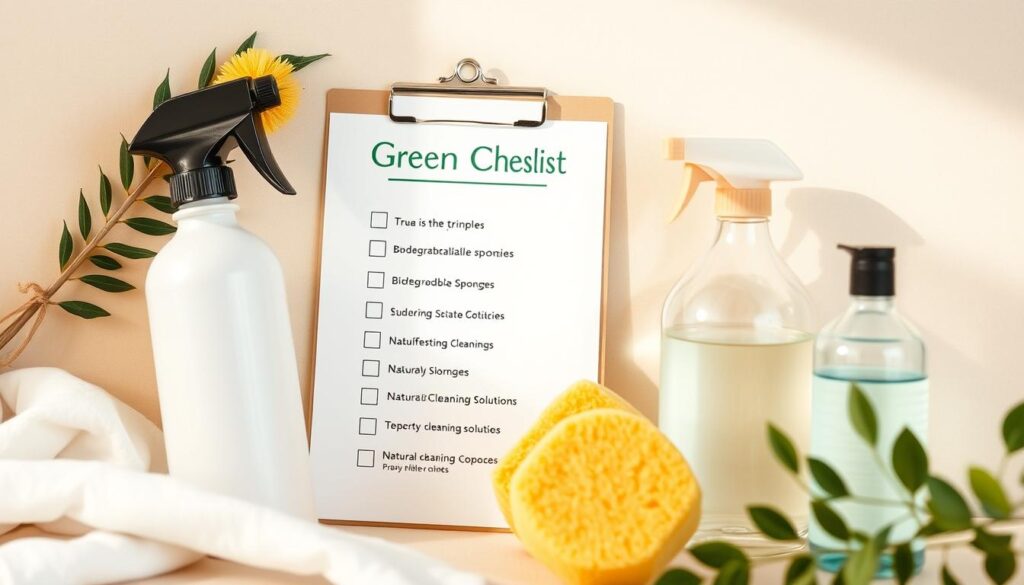
Comparing Eco-Cleaning Products to Conventional Options
When looking at eco-friendly versus regular cleaners, it’s not just about how well they clean. Eco-friendly cleaners use safe, biodegradable materials. This means they are less likely to harm our water. About 25% of regular cleaners have dangerous chemicals that can hurt water life.
Green cleaning products are getting better and are as strong as conventional ones. Studies show that 70% of shoppers like products with fewer ingredients. This matches the move towards simple yet strong green products. These clean well and are better for the planet.
Eco-friendly products also lead in less plastic use. They use up to 90% less plastic than regular products. This helps fight the big problem of plastic trash in our oceans, with 8 million tons of plastic dumped each year. A regular household can make about 40 pounds of plastic trash a year from cleaning products.
Here’s a quick look at how green and traditional cleaning products compare:
| Aspect | Eco-Friendly Cleaners | Conventional Cleaners |
|---|---|---|
| Plastic Waste | Uses up to 90% less plastic | Average 40 pounds of plastic waste annually |
| Ingredient Transparency | 70% of consumers prefer fewer ingredients | May contain harmful chemicals |
| Environmental Impact | Reduces chemical runoff by up to 60% | 30% of consumers report being misled by greenwashing |
| Carbon Emissions | Concentrated products can cut emissions by ~50% | Higher emissions due to heavier packaging |
Think about the environmental effects of these two choices. The demand for green products is growing fast, with an expected growth of 11% yearly from 2023 to 2030. Brands that focus on being green often see a 20-30% increase in sales each year. This shows more people are choosing products that are good for the earth.
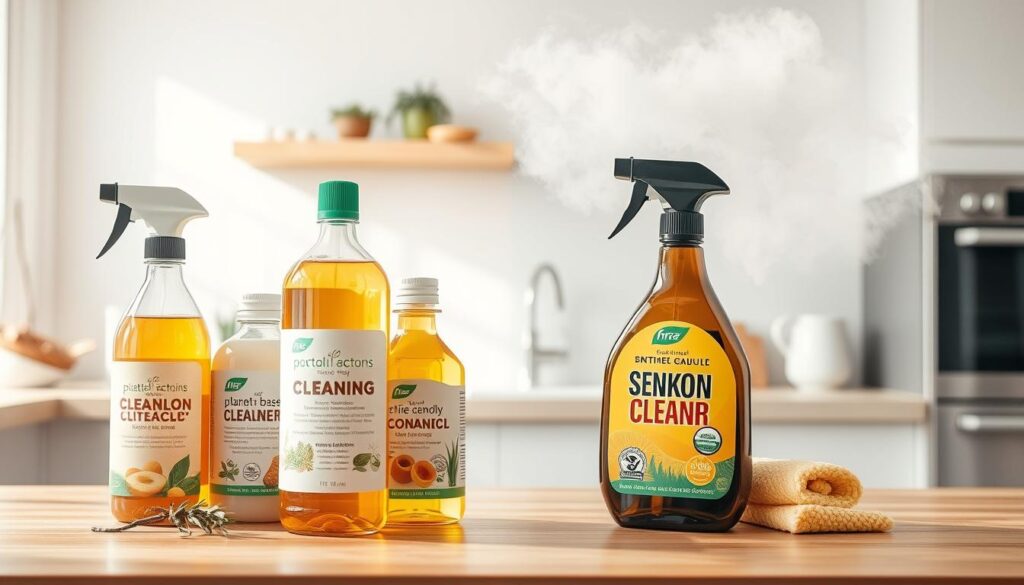
Things to Avoid When Selecting Green Products
When you’re looking for green cleaning products, be aware of common pitfalls in selecting green cleaners. Words like “natural” and “eco-friendly” often don’t mean what we think. To choose wisely, focus on these key elements.
- Eco-label misinterpretation can lead to buying products that aren’t as green as they claim. Many brands say they’re eco-friendly without actually being certified.
- Be on the lookout for harmful ingredients to avoid. Toxic fragrances and certain preservatives can harm your health.
- Greenwashing is a trick companies use to seem eco-conscious. Yet, their products may still be damaging to the environment.
Reading labels can teach us a lot. For example, products with bleach and ammonia kill germs well. But, they pollute the air inside our homes and can bother people with breathing issues.
| Product Type | Pros | Cons |
|---|---|---|
| Traditional Cleaners | Kills 99.9% of bacteria | Releases VOCs, irritates allergies |
| Probiotic Cleaners | Longer-lasting protection | Less mainstream availability |
| Eco-Friendly Cleaners | Improves indoor air quality | Higher initial cost misconception |
Companies like Blueland and Cleancult stress the value of being sustainable with refillable packages. This method cuts down on single-use plastic waste. It helps us reach our green cleaning targets. The EWG’s ‘Guide to Healthy Cleaning’ is a helpful tool. It guides us in picking products that are safe and truly eco-friendly.
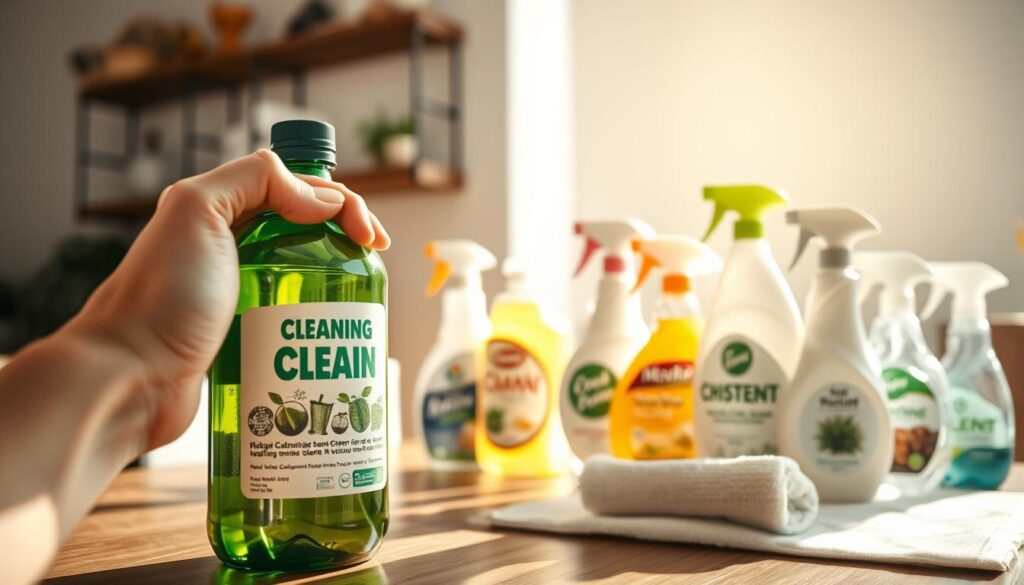
How to Make Your Cleaning Routine More Eco-Friendly
Making your cleaning routine eco-friendly can be rewarding. Start by adding sustainable habits to your routine every day. Try using microfiber cloths instead of paper towels to reduce waste and keep surfaces clean. They can be reused many times, making them a smart choice.
Making your own cleaning products is also a great idea. Mix common items like baking soda, white vinegar, and lemon juice for effective cleaning solutions. This cuts down on harmful chemicals and is cheaper, keeping your home safe and saving you money.
It’s important to use water wisely too. Always wash full loads of dishes and clothes. This saves water and energy, helping our planet. Using concentrated cleaning products also helps by reducing packaging and your carbon footprint.
Buying reusable cleaning items is a smart investment. They might cost more at first, but you’ll save money over time. For instance, reusable wool dryer balls can replace disposable dryer sheets and last for years.
By following these eco-friendly tips, you improve your health and the planet’s. Even small changes can make a big difference, leading to a cleaner home and a better world.
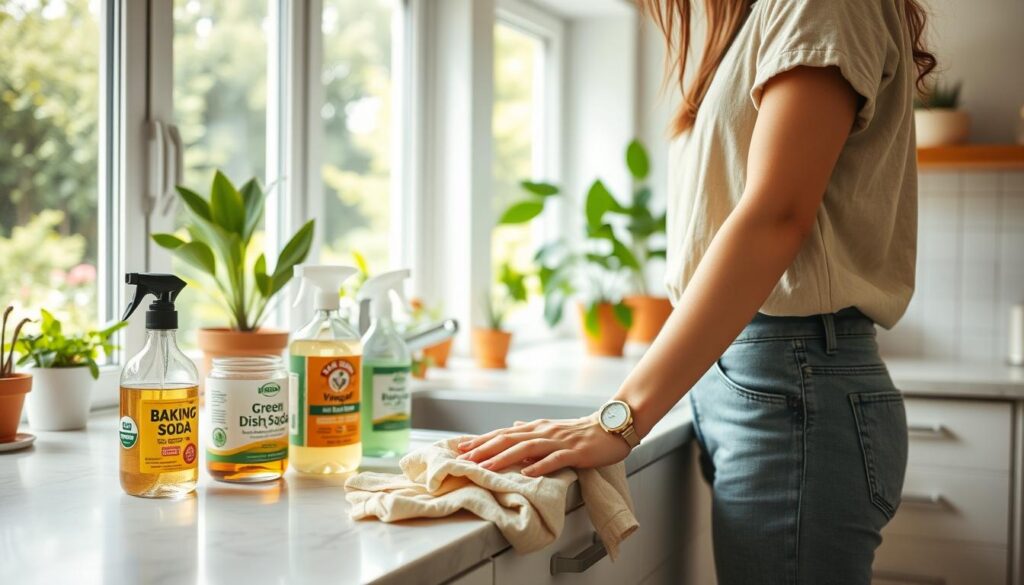
Conclusion
We’ve come to the end of our eco-cleaning journey. It’s clear that going green can change your home and the earth for the better. Switching to eco-friendly cleaning options boosts your home’s air quality. Plus, it keeps your family, pets, and the planet safe.
Starting your sustainable life means choosing wisely and loving green products. Brands like Dr. Bronner’s and Blueland offer natural and effective cleaning choices. And don’t forget, making your own cleaners with items like vinegar or baking soda saves cash and cuts down on waste.
When picking cleaning supplies, focus on those that are open about ingredients and use less packaging. Embracing eco-friendly items shows your commitment to a cleaner future. Every choice you make helps, leading to cleaner homes and a healthier earth.
FAQ
What are the main benefits of eco-cleaning?
How do I identify eco-friendly cleaning products?
Can I make my own eco-friendly cleaners?
Are eco-cleaning products as effective as conventional cleaners?
What should I avoid when choosing green cleaning products?
How can I make my cleaning routine more eco-friendly?
What are some common ingredients in green cleaning products?
Source Links
- https://www.amazon.co.uk/Clean-Green-Hints-Tips-Eco-Friendly/dp/1529049725 – 101 Hints and Tips for a More Eco-Friendly Home: Amazon.co.uk: Birtwhistle, Nancy, Mitchell, Emma: 9781529049725: Books
- https://www.onlyorganic.org/green-living-101-a-beginners-guide-to-an-organic-lifestyle/ – Green Living 101: A Beginner’s Guide to an Organic Lifestyle | Organic Voices
- https://makylacreates.com/natural-eco-cleaning-guide-101/ – Natural Cleaning 101 – Eco Cleaning Guide – Makyla Creates
- https://earthbuddies.net/the-importance-of-choosing-eco-friendly-cleaning-services-for-your-home/ – The Importance of Choosing Eco-Friendly Cleaning Services for Your Home
- https://letsgogreen.com/sustainable-home/eco-friendly-cleaning-products/ – A Complete Guide To Eco-Friendly Cleaning Products – Let’s Go Green
- https://hyveclean.com/blog/beginners-guide-to-green-cleaning-switching-to-organic-products?srsltid=AfmBOoryvai6atxTj1wVekaLnj5AH-aOGw4DaTbIjnTTuBt0whmIT3pN – Beginner’s Guide to Green Cleaning: Switching to Organic Products
- https://righttouchhousecleaning.com/a-beginners-guide-to-green-cleaning/ – A Beginners Guide to Green Cleaning | Right Touch Residential Cleaning
- https://hyveclean.com/blog/beginners-guide-to-green-cleaning-switching-to-organic-products?srsltid=AfmBOoq51_o5yNgN4RagXpW6fPQDuOY2rZB3LmfXPnoW9UO3vSiy1ECO – Beginner’s Guide to Green Cleaning: Switching to Organic Products
- https://greenllamaclean.com/blogs/green-eco-friendly-facts/learn-why-eco-friendly-cleaning-products-are-better-for-your-health-and-the-environment?srsltid=AfmBOooUzsKazrVL0mfsf9lUPgDdOBYGW2Jes7fdn4HvZEl67p9OCvoU – Why Choose Eco-Friendly Cleaning Products? A Guide by Green Llama Clean
- https://hyveclean.com/blog/beginners-guide-to-green-cleaning-switching-to-organic-products?srsltid=AfmBOoqxWSGiXuJpXbMQyOeUvj2Fz4ATsSgSXmVr7tDOViTN5f4nTEdw – Beginner’s Guide to Green Cleaning: Switching to Organic Products
- https://skipper.org/blogs/insights/identify-environmentally-friendly-cleaning-products?srsltid=AfmBOophDChm2h7XKkt7FTB_kUlY0ET9F9IoQxrshWF3kXgCzrceV5RN – How to Identify Environmentally-Friendly Cleaning Products
- https://ecofriend.com/how-to-choose-green-cleaning-professionals-key-factors-to-consider.html – How to Choose Green Cleaning Professionals: Key Factors to Consider – Ecofriend
- https://www.sustainablylazy.com/blog/homemade-diy-cleaner – The Beginner’s Guide To Homemade DIY Cleaners (No Vinegar) — Sustainably Lazy
- https://hyveclean.com/blog/beginners-guide-to-green-cleaning-switching-to-organic-products?srsltid=AfmBOooU3UVwlojNP4q_PqnDbaerHWJUVkIMis-f_nwXDl_95WBInKkE – Beginner’s Guide to Green Cleaning: Switching to Organic Products
- https://eleganszone.com/blog/a-beginner-s-guide-to-eco-friendly-cleaning-solutions – A Beginner’s Guide to Eco-Friendly Cleaning Solutions
- https://hyveclean.com/blog/beginners-guide-to-green-cleaning-switching-to-organic-products?srsltid=AfmBOopmu7X8omY0ecgSHWALEMkl-iu1tHl9jsBj-keHtXXuVveYG6ym – Beginner’s Guide to Green Cleaning: Switching to Organic Products
- https://skipper.org/blogs/insights/identify-environmentally-friendly-cleaning-products?srsltid=AfmBOooWwAZ2yDBMyXnUDilRW5XvD6N0xJ1XmTDYnkUFZgyFGGyXQr3z – How to Identify Environmentally-Friendly Cleaning Products
- https://www.goodvibesclean.com/blogs/the-peaceful-home/the-ultimate-guide-to-plant-based-cleaning?srsltid=AfmBOoqgDn14xv_nf0VlpB7MRER5on1Ut5144vd7Sdeh2Ov7Ubz7GkTD – The Ultimate Guide to Plant-Based Cleaning
- https://hyveclean.com/blog/beginners-guide-to-green-cleaning-switching-to-organic-products?srsltid=AfmBOoqPgZNPvvQOcKr_EXuKL_3I88i_Og0cxKja5kECZGzzrHgF2V63 – Beginner’s Guide to Green Cleaning: Switching to Organic Products
- https://ecochores.com/2024/09/13/cleaning-with-green-a-beginners-guide-to-sustainable-home-cleaning-practices/ – Cleaning with Green: A Beginner’s Guide to Sustainable Home Cleaning Practices
- https://www.wired.com/story/eco-friendly-natural-cleaning-products/ – The Best Eco-Friendly Cleaning Products for Your Home
- https://skipper.org/blogs/insights/identify-environmentally-friendly-cleaning-products?srsltid=AfmBOorqUK91TvYwWlirt-83pF30fHZuic6DbXkEIK-Xo8h1oA3KMtQT – How to Identify Environmentally-Friendly Cleaning Products
- https://www.theateamcleaning.net/eco-friendly-cleaning-gadgets-beginners-guide/ – Eco-Friendly Cleaning Gadgets: [Beginner’s Guide]
- https://hyveclean.com/blog/beginners-guide-to-green-cleaning-switching-to-organic-products?srsltid=AfmBOopnF6L2pnea7cq4sUVCUKs2U0f2bnwjpa9bk5yfCk1nTUQaRqYe – Beginner’s Guide to Green Cleaning: Switching to Organic Products
- https://www.thegoodtrade.com/features/natural-nontoxic-cleaning-products/ – 11 Best Natural And Nontoxic Cleaning Products (2025)
- https://aspenclean.com/blogs/sustainable-living/avoid-cleaning-product-greenwashing?srsltid=AfmBOooDfwyza7HXlOhdP7cWV1MVB3F7cMrT8hi6EuDZ3T8QxeFAE_xc – How to Avoid Cleaning Product Greenwashing | AspenClean
- https://www.bhg.com/homekeeping/house-cleaning/tips/eco-friendly-cleaning-ideas/ – 7 Simple Ways to Go Green with Your Cleaning Routine
- https://www.greenwashingindex.com/green-cleaning-habits/ – 10 Green Cleaning Habits: Your Guide to a Zero-Waste Home
- https://www.greenerwisdom.com/blog/environmentally-friendly-house-cleaners – An Overview of Environmentally Friendly House Cleaners · Greener Wisdom
- https://topmopscleaning.com/2023/10/21/green-cleaning-a-sustainable-choice-for-a-cleaner-home/ – Green Cleaning: A Sustainable Choice for a Cleaner Home – Top Mops Cleaning | Lexington, KY Maid Services
